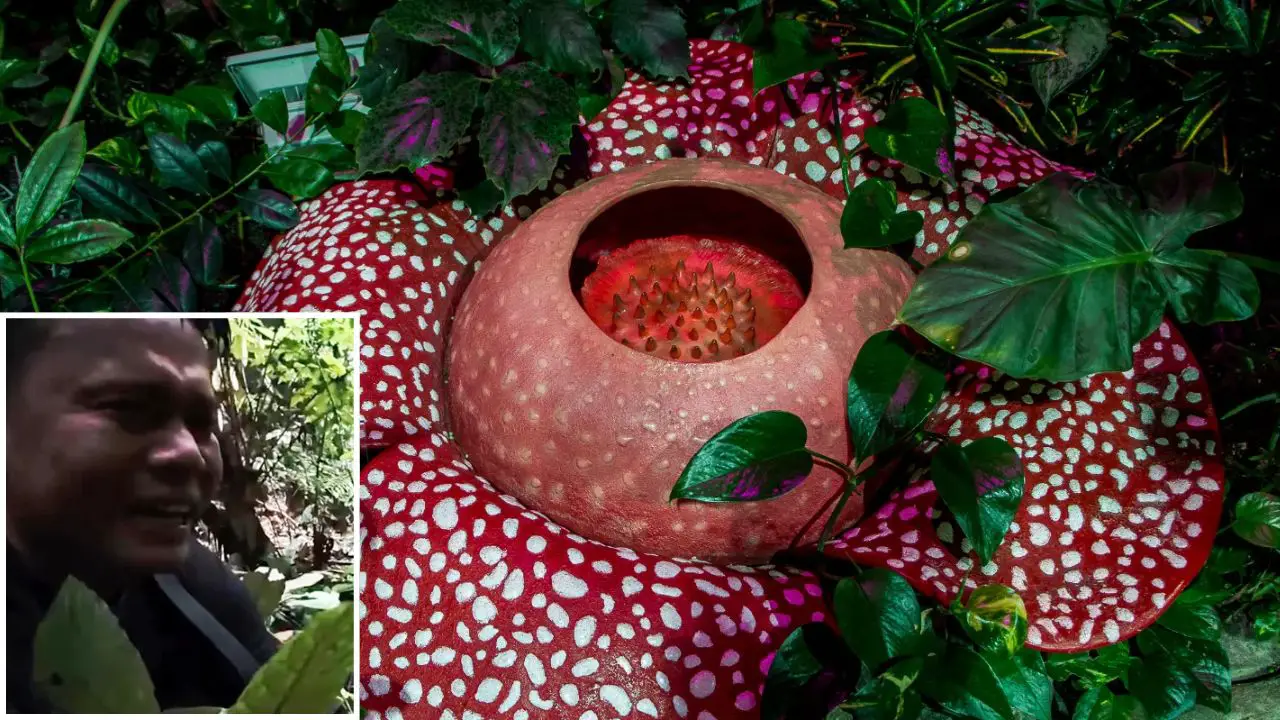Deep inside the dense, tiger-patrolled rainforests of Sumatra, two researchers from the Oxford Botanic Garden made a once-in-a-lifetime discovery that left one of them openly sobbing with joy. After 13 years of searching, biologist Septian Andrikithat finally found a flowering Rafflesia hasseltii, a plant so elusive that scientists believe more wild tigers have seen it than humans.
The discovery — captured on video and shared worldwide — has sparked global fascination due to the flower’s otherworldly, almost alien appearance and its near-mythical rarity.
A Discovery Decades in the Making
Dr. Chris Thorogood, Deputy Director of Oxford Botanic Garden, and field biologist Septian Andrikithat had spent years studying the region’s plant biodiversity. But their latest expedition turned historic when they finally located a blooming Rafflesia deep within Sumatra’s remote interior.
The University of Oxford shared the moment online, noting that the team had “trekked day and night through tiger-patrolled Sumatran rain forests” in search of the plant.
“This is one of the rarest flowers on Earth,” the University wrote. “Finding it in bloom is an extraordinary achievement.”
Footage of Andrikithat collapsing to his knees in tears upon finding the plant quickly went viral. The clip now has over 8 million views on TikTok alone, with viewers around the world moved by his raw emotional reaction.
The Extraordinary Rafflesia hasseltii
Known locally as Cendawan Muca Rimau, meaning “Tiger-faced Mushroom,” the Rafflesia is unlike any other plant on Earth. Its massive, fleshy bloom resembles something from a sci-fi set — often compared to Avatar, Stranger Things, and other fantasy worlds.
But its stunning beauty is matched by its extreme rarity.
Botanists consider it the rarest flowering plant in the world, and for good reason:
- It blooms for just 5–7 days
- After blooming, the flower dies quickly, leaving only decaying plant matter behind
- It is a parasitic plant, living entirely inside a specific host vine
- There are no visible stems, leaves, or roots, making it nearly impossible to track
- It grows in remote, dangerous rainforests populated by wild Sumatran tigers
Because the flower spends most of its life hidden inside a vine, researchers must rely on timing, luck, and experience to be present during its short blooming window.
Why the Search Is So Difficult
Tracking Rafflesia requires navigating some of the most challenging ecosystems on the planet. Sumatra’s interior is humid, densely vegetated, and filled with unpredictable wildlife, including critically endangered tigers.
The combination of dangerous terrain, host vine scarcity, and the flower’s brief blooming cycle makes each discovery a scientific milestone.
“Being in these habitats is not easy,” Thorogood explained. “And finding a healthy, open bloom of Rafflesia is close to impossible.”
This difficulty is precisely why Andrikithat’s emotional reaction resonated worldwide. His 13-year search represents not just personal dedication, but a broader effort to document and protect fragile species threatened by deforestation and climate change.
Why This Discovery Matters
Rafflesia species are under serious threat. Many populations are shrinking due to:
- Habitat destruction from logging and agriculture
- Loss of host vines
- Limited reproductive success
- Climate instability
Researchers hope the viral video will draw greater attention to conservation efforts across Indonesia’s rainforest ecosystems.
The Oxford team continues to work with local scientists and authorities to better document and protect Rafflesia populations, which may hold critical ecological value yet to be fully understood.
A Moment That Captured the World
In a time when environmental news often feels bleak, this moment of pure scientific triumph has inspired millions. It offered a rare glimpse into the emotional side of field research — the exhaustion, perseverance, and awe that come with dedicating one’s life to understanding nature.
As the video continues to spread, people around the world are joining the effort to highlight the importance of protecting Earth’s most extraordinary and endangered species.
Want More Inspiring Human Stories?
For more uplifting, surprising, and discussion-worthy stories, visit mikeandjonpodcast.com.




